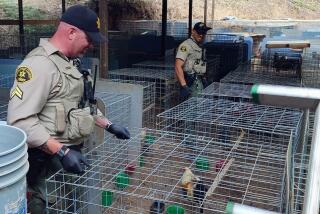Henpecked Cowpokes : Raising Ostriches Ruffles Feathers of Old-Time Cattlemen
STONYFORD, Calif. — Life hasn’t been the same the last couple of years on the 1,800-acre Flying S Ranch in Northern California’s sparsely populated Colusa County, where Ray Williams runs a herd of Brahman cattle.
Williams, 47, has been a cowboy all his life, all over the West, working many different breeds of cattle and even buffalo and sheep.
“When I first came to this country nobody had Brahmans, but everybody’s accustomed to them now. It’s these damn birds that’s changin’ things around. Biggest birds on earth,” allowed Williams.
Clowns of Bird World
He was surrounded by the clowns of the bird world, enormous, eight-foot, 300- to 325-pound, flightless ostriches with skinny limber necks nearly half their length and funny, fuzzy small heads with duck-like bills, soft brown eyes and thick black eyelashes.
“Whoever thought ranching would come to this,” sighed the cowpoke as one of the ostriches began pecking at his jacket buttons. Williams raised his finger in the air, admonishing the bird to cut it out.
Another big bird uncorked its neck and in a flash with its bill grabbed the cap off the cowboy’s head. “Give that back,” shouted Williams sternly, and the ostrich dropped his lid. “Playful critters aren’t they?” mused the cowboy.
The Flying S is one of a dozen ostrich farms and ranches in California, one of about 200 growers in the nation with a total of about 5,000 birds, mostly in Texas and Oklahoma. Ostrich farms are an answer to trade sanctions against South Africa imposed in 1986.
Until then, this country had been importing upward of 90,000 ostrich hides a year from South Africa. The soft grained leather is used to make purses, belts, shoes and boots.
Now the big push among ostrich growers is to build up numbers. The birds command a lot of money: $2,000 for a chick, $25,000 to $35,000 for breeding adults.
“Ostriches are going to be big business in America within a few years, just you watch and see,” said Svend Steffen, 54, owner of the Flying S who also owns and operates a steel company in Redwood City. “Not only for the hides, but for the meat and feathers as well,” he added.
An ostrich yields 90 pounds of cholesterol-free, beef-like meat. “Ostrich meat is a popular dinner item in South Africa. I never tire of eating ostrich. It tastes great,” insisted Steffen. He has 22 ostriches and plans to have as many as 200 within a few months.
“These birds are similar to chickens in many ways,” chimed in Williams. “Males are called roosters, females, hens, babies, chicks. Like chickens they roost at night and males, like barnyard roosters, make a lot of noise at sunup. Male ostriches make a booming noise. It makes your hair stand on end. It’s like something you’ve never heard before.”
The cowboy laughed and said, “Imagine eating an ostrich drumstick. One drumstick is enough to feed nearly a dozen people. One ostrich egg weighs three pounds and equals 26 chicken eggs.” An ostrich hen lays an egg every other day with a total of 40 to 60 eggs in a laying season. Eggs hatch out in 42 days.
Ostrich Runways
The big birds on the Flying S Ranch are kept in two acres embraced by a six-foot high fence. Eight 200-foot-long runways are in the ostrich yard. The birds exercise by racing back and forth at speeds at times in excess of 40 m.p.h.
“You don’t cowboy ostriches. No way is anybody going to lasso one of those characters,” observed Williams, who begins his day at sunup feeding his birds corn, barley and alfalfa pellets.
“They’re waiting at the gate to greet me. I kind of take a shine to some of the friendlier birds like Big John over there and Sam and this hen I call Lucy,” said Williams, scratching Lucy on her long neck.
The rest of the day, Williams is out on the ranch cowboying like most cowboys do--with cows, not birds.
More to Read
Sign up for Essential California
The most important California stories and recommendations in your inbox every morning.
You may occasionally receive promotional content from the Los Angeles Times.










